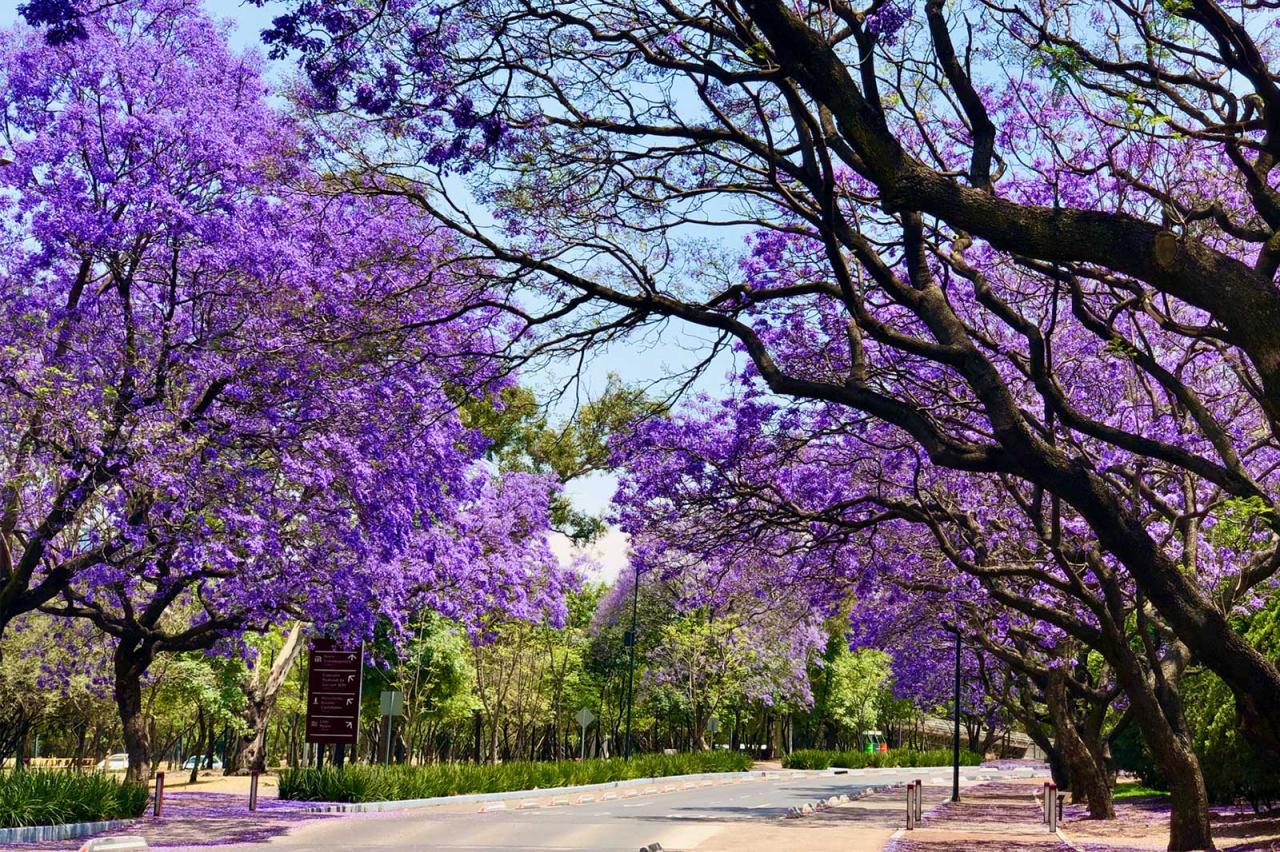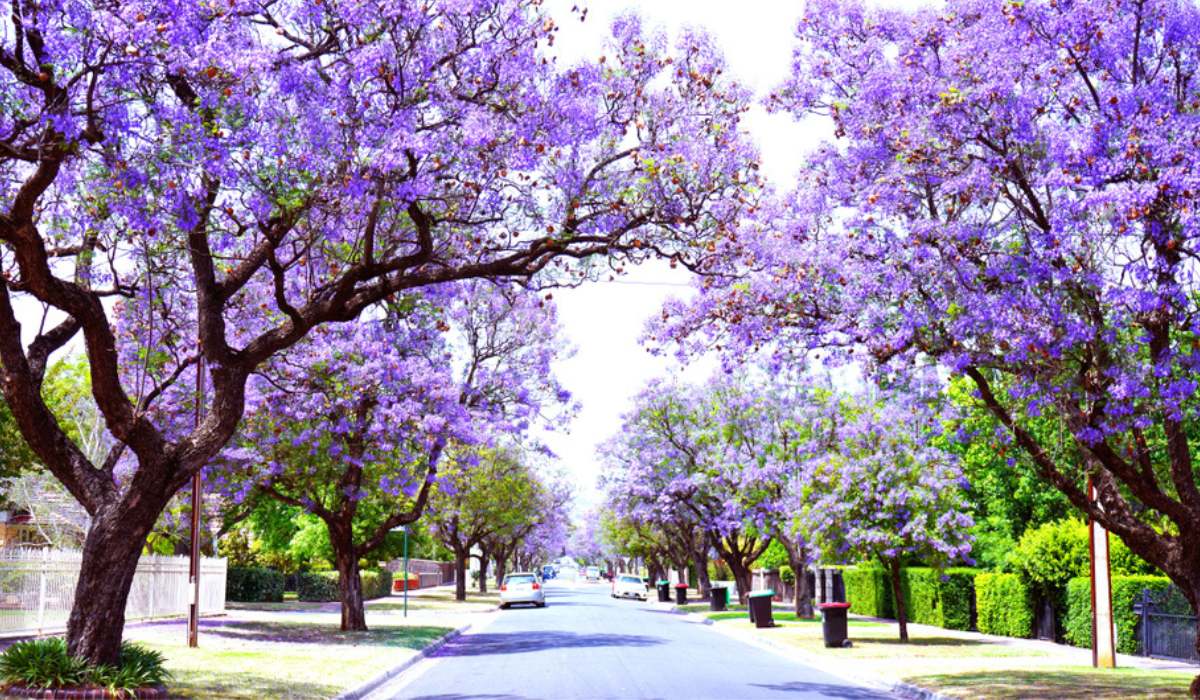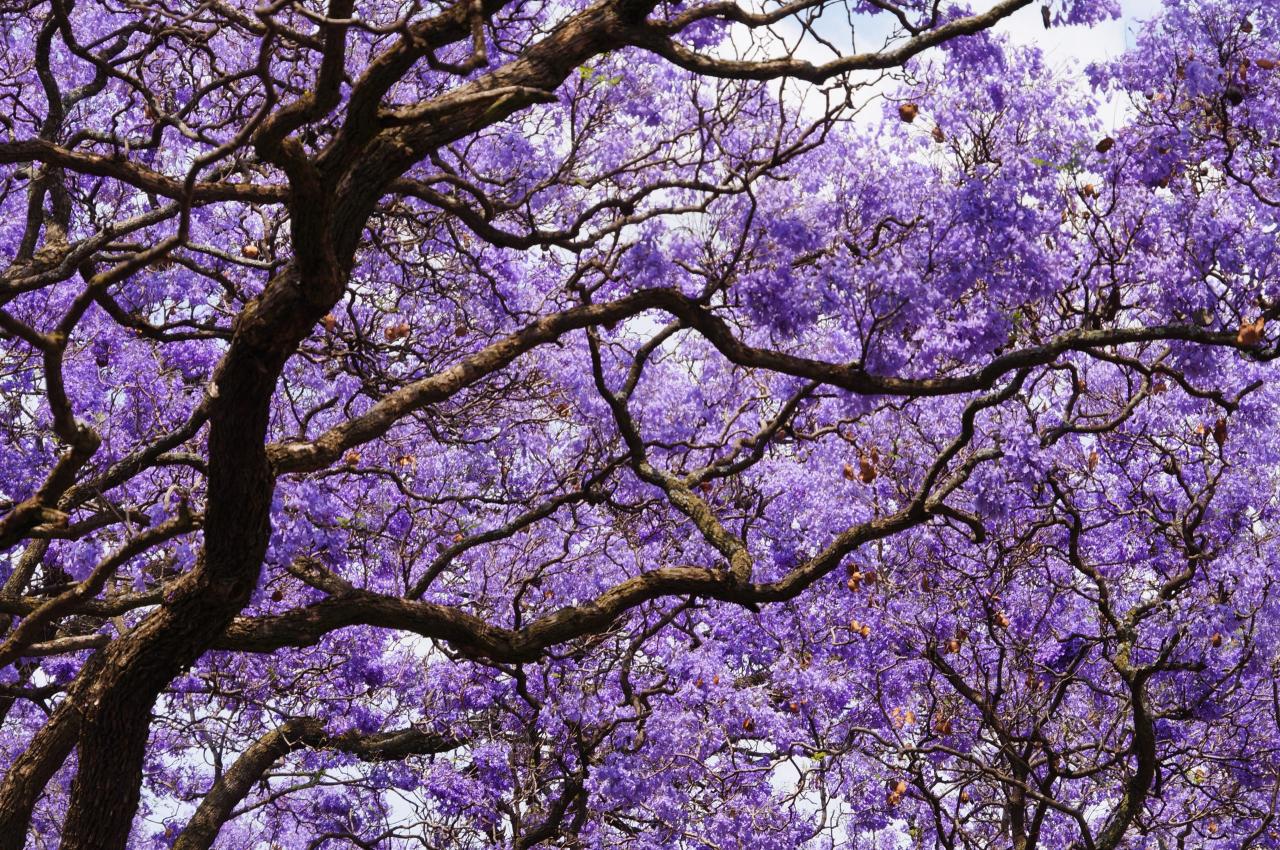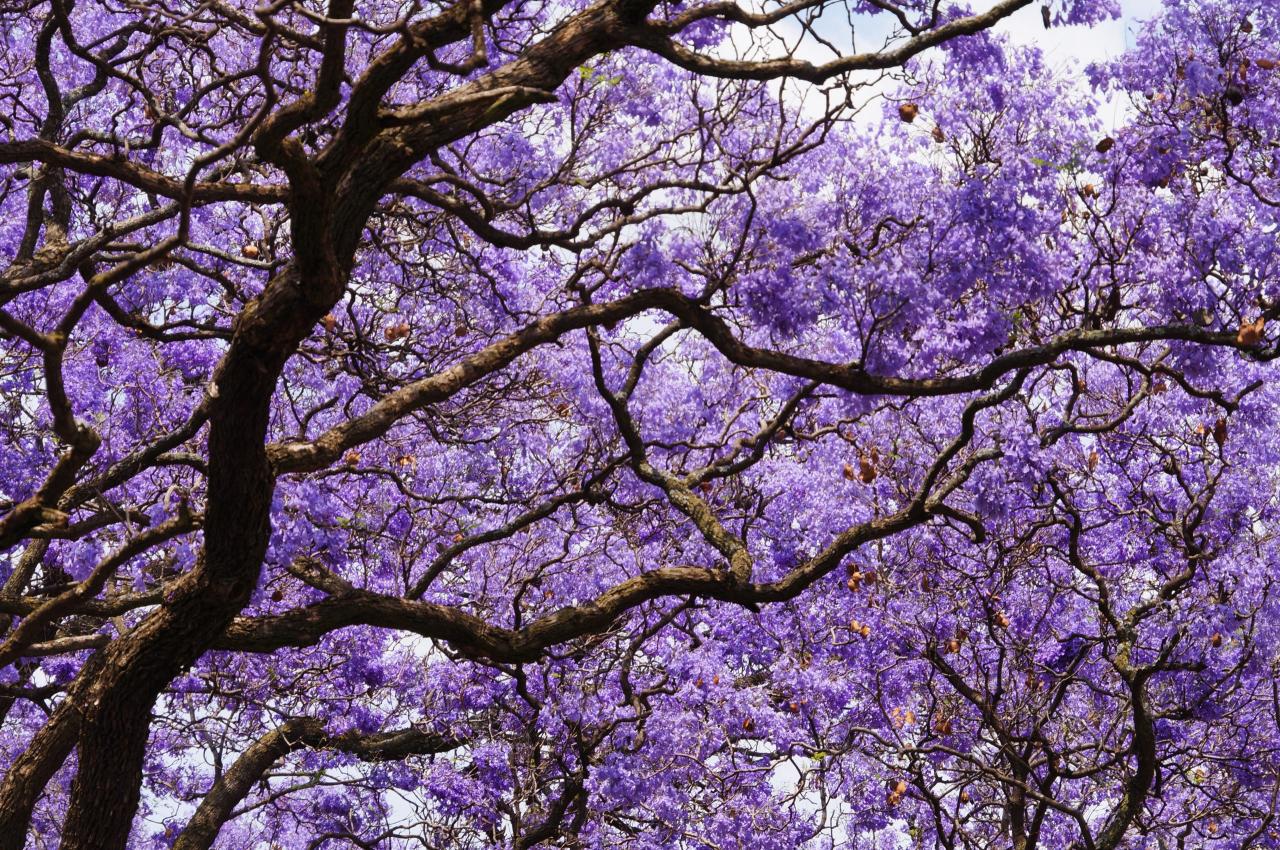The Ultimate Guide to Jacaranda Tree: Tips for Achieving Beautiful and Vibrant Blooms – Imagine a tree bursting with a symphony of vibrant purple blooms, painting a picturesque landscape with its ethereal beauty. That’s the magic of the Jacaranda tree, a captivating species that has captivated hearts worldwide.
This guide delves into the world of Jacaranda trees, offering a comprehensive exploration of their history, characteristics, and the secrets to cultivating these breathtaking beauties. From choosing the right variety to mastering the art of care, this guide equips you with the knowledge to nurture your own Jacaranda haven.
Jacaranda trees, native to South America, have become beloved symbols of spring in many parts of the world. Their distinctive blue-violet blooms, resembling delicate bells, transform landscapes into a mesmerizing spectacle. But beyond their aesthetic appeal, Jacaranda trees possess a rich cultural significance, representing wisdom, prosperity, and good luck.
Whether you’re an experienced gardener or a curious newcomer, this guide will serve as your compass, guiding you through the intricacies of growing these enchanting trees.
Introduction to the Jacaranda Tree
The Jacaranda tree, with its vibrant purple blooms, is a captivating sight that transforms landscapes into a spectacle of color. Native to South America, the Jacaranda tree has a rich history and cultural significance, making it a beloved species across the globe.
This guide delves into the fascinating world of the Jacaranda tree, exploring its origins, characteristics, and the secrets to achieving stunning blooms. From its unique botanical features to its cultural impact, we will uncover the beauty and allure of this remarkable tree.
Origins and History
The Jacaranda tree, scientifically known as Jacaranda mimosifolia, belongs to the Bignoniaceae family. It is native to the subtropical regions of South America, particularly Argentina, Bolivia, and Brazil. The tree’s name is derived from the indigenous Tupi language, “jacaranda,” which translates to “fragrant.”
The Jacaranda tree was introduced to other parts of the world in the 19th century, where it quickly gained popularity for its ornamental value. It was first introduced to Australia in the 1840s, and its popularity spread to other countries like South Africa, India, and the United States.
Unique Characteristics
The Jacaranda tree is known for its distinctive characteristics that contribute to its beauty and appeal.
- Stunning Purple Blooms:The Jacaranda tree is most recognized for its spectacular purple flowers that resemble delicate bells. These flowers appear in clusters, creating a breathtaking spectacle when in full bloom.
- Feathery Leaves:The Jacaranda tree has beautiful, feathery leaves that resemble fern fronds. These leaves provide a lush, tropical appearance and create a dappled shade beneath the tree.
- Rapid Growth:Jacaranda trees are fast-growing, reaching heights of up to 50 feet in optimal conditions. This rapid growth makes them a popular choice for landscaping and shade trees.
- Hardiness:Jacaranda trees are relatively hardy and can tolerate a range of climates, making them adaptable to various environments.
Cultural Significance
The Jacaranda tree holds cultural significance in many parts of the world. In South Africa, the Jacaranda blooms coincide with the university examination period, leading to the belief that a bloom under a Jacaranda tree signifies good luck in exams.
In Australia, the Jacaranda tree is associated with spring and is celebrated with festivals and events. The city of Grafton, New South Wales, is known as the “Jacaranda City” and hosts an annual Jacaranda Festival in October.
The Beauty and Allure of Jacaranda Blooms
The Jacaranda tree’s beauty lies in its stunning purple blooms. These flowers are a vibrant and captivating sight, transforming landscapes into a sea of color. The delicate bell-shaped flowers are arranged in clusters, creating a mesmerizing spectacle when in full bloom.
The Jacaranda blooms are a symbol of beauty, joy, and good luck. They are often associated with spring and the arrival of new beginnings. The tree’s stunning purple flowers are a reminder of the beauty that surrounds us and the wonders of nature.
Choosing the Right Jacaranda Tree
Selecting the appropriate Jacaranda tree variety is crucial for successful growth and achieving beautiful blooms. Different varieties possess unique characteristics and thrive in specific climates. Understanding these differences will help you choose the right Jacaranda for your location, ensuring it flourishes and graces your landscape with its vibrant purple flowers.
Jacaranda Tree Varieties
Jacaranda trees offer a range of options, each with its own distinct features. Here are some popular varieties and their suitability for different climates:
- Jacaranda mimosifolia:The most common variety, known for its striking purple blooms and rapid growth. It thrives in warm climates and is well-suited for USDA hardiness zones 9-11. This variety can tolerate some frost, but it may experience leaf drop during colder periods.
It typically reaches heights of 40-60 feet, making it suitable for larger gardens and parks.
- Jacaranda acutifolia:This variety is also known as the “blue Jacaranda” due to its deep blue flowers. It prefers warmer climates and is suitable for USDA hardiness zones 10-11. It grows slightly smaller than J. mimosifolia, reaching heights of 30-40 feet, making it a good choice for smaller spaces.
- Jacaranda oxyphylla:This variety is native to Australia and boasts smaller, more delicate leaves compared to other Jacarandas. It produces clusters of lavender-blue flowers and thrives in warmer climates. It’s suitable for USDA hardiness zones 9-11 and typically reaches heights of 20-30 feet.
- Jacaranda caerulea:This variety is native to Brazil and features larger, more vibrant purple flowers than J. mimosifolia. It prefers warm, humid climates and is suitable for USDA hardiness zones 10-11. It can grow to heights of 50-60 feet, making it a suitable choice for larger gardens and parks.
Factors to Consider When Choosing a Jacaranda Tree
Choosing the right Jacaranda tree for your location involves several key factors:
- Space Availability:Jacaranda trees can grow quite large, so it’s essential to consider the available space in your garden or yard. Measure the area where you plan to plant the tree and choose a variety that will fit comfortably without encroaching on other plants or structures.
- Soil Type:Jacaranda trees prefer well-drained soil that is slightly acidic to neutral. Before planting, test your soil pH and amend it if necessary. Poor drainage can lead to root rot and other problems.
- Climate:Different Jacaranda varieties have different cold tolerance levels. Choose a variety that is suitable for your climate. For example, if you live in a colder region, you might want to consider a variety that is known to be more frost-tolerant.
- Bloom Time:Jacaranda trees typically bloom in spring and summer, but the exact timing can vary depending on the variety and climate. If you’re looking for a tree that will bloom at a specific time of year, research the bloom period of different varieties.
Importance of Choosing a Healthy Tree
Selecting a healthy and well-established Jacaranda tree is crucial for successful growth. Look for a tree that has a strong root system and a healthy canopy. Avoid trees that show signs of disease, pest damage, or stress. A healthy tree is more likely to thrive in its new environment and produce vibrant blooms.
Planting and Care
Planting a Jacaranda tree is an exciting endeavor that promises a vibrant splash of color in your landscape. Selecting the right location and ensuring proper care are crucial for a healthy and thriving Jacaranda.
Planting a Jacaranda Tree
The best time to plant a Jacaranda tree is during the spring or fall when the weather is mild and the soil is moist. Before planting, prepare the soil by loosening it to a depth of 12-18 inches and incorporating compost or other organic matter to improve drainage and fertility.
- Dig a holethat is twice as wide and as deep as the root ball of the tree.
- Place the treein the hole, ensuring the top of the root ball is level with the ground.
- Backfill the holewith the soil, gently tamping it down to remove air pockets.
- Water the treethoroughly to settle the soil and encourage root growth.
- Space Jacaranda treesat least 15-20 feet apart to allow for adequate growth and prevent overcrowding.
Watering a Jacaranda Tree
Jacaranda trees prefer well-drained soil and require regular watering, especially during the first year after planting. Water deeply and infrequently, allowing the soil to dry slightly between waterings. During hot and dry weather, you may need to water more frequently.
Fertilizing a Jacaranda Tree
Jacaranda trees benefit from regular fertilization, particularly during the spring and summer months when they are actively growing. Use a balanced fertilizer formulated for flowering trees, following the instructions on the product label.
Mulching a Jacaranda Tree
Mulching around the base of a Jacaranda tree helps to retain moisture, regulate soil temperature, and suppress weeds. Apply a 2-4 inch layer of organic mulch, such as wood chips, shredded bark, or compost, around the tree, keeping it away from the trunk.
Pruning a Jacaranda Tree
Pruning a Jacaranda tree is essential for shaping, maintaining size, and promoting healthy growth.
- Prune during the dormant season, typically in late winter or early spring, before new growth emerges.
- Remove any dead, diseased, or damaged branchesto maintain the tree’s health and prevent the spread of disease.
- Thin out the canopyto improve air circulation and sunlight penetration, which can enhance blooming.
- Shape the treeby removing branches that are growing in undesirable directions or interfering with other plants.
Achieving Vibrant Blooms
Jacaranda trees are renowned for their breathtaking displays of vibrant purple blooms, transforming landscapes into ethereal scenes. To witness this spectacle in your own garden, understanding the factors that influence bloom production is crucial. This section delves into the key aspects of achieving abundant and vibrant blooms on your Jacaranda tree.
Sunlight and Bloom Production
Sunlight is a fundamental requirement for Jacaranda trees to thrive and produce an abundance of blooms. These trees are sun-loving and require at least six hours of direct sunlight daily to flourish. Adequate sunlight exposure ensures optimal photosynthesis, the process by which plants convert light energy into chemical energy, which is essential for growth and flowering.
Without sufficient sunlight, the tree may struggle to produce blooms or may exhibit fewer and smaller blooms.
Soil pH and Nutrient Availability
The soil pH and nutrient availability play a critical role in the health and flowering of Jacaranda trees. Jacarandas prefer slightly acidic to neutral soil with a pH range of 6.0 to 7.0. Soil that is too acidic or alkaline can hinder nutrient uptake, leading to stunted growth and reduced bloom production.
Additionally, the availability of essential nutrients, particularly phosphorus and potassium, is crucial for healthy flowering. A soil test can determine the pH and nutrient levels in your soil, allowing you to make necessary adjustments through amendments and fertilization.
While the Jacaranda tree thrives on warmth and sunshine, its vibrant blooms are also a testament to the power of proper care and technique. Just like cultivating a stunning wall of ivy requires understanding the right propagation methods, How to Create a Wall of Ivy with These Propagation Methods , achieving those breathtaking purple blossoms hinges on the right approach.
This guide delves into the secrets of nurturing your Jacaranda tree to ensure a dazzling display of color each year.
Managing Pests and Diseases
Pests and diseases can significantly impact the health and flowering of Jacaranda trees. Common pests include aphids, scale insects, and mealybugs, which can damage foliage and sap flow, hindering bloom production. Diseases such as powdery mildew and leaf spot can also affect the tree’s health and flowering.
Regular inspection for signs of pests and diseases is essential. Early detection and treatment are crucial to prevent significant damage to the tree and its blooms.
Jacaranda Trees in Landscaping
Jacaranda trees are a popular choice for landscaping due to their stunning purple blooms, graceful form, and ability to adapt to various climates. They can be incorporated into a variety of landscape designs, from formal gardens to informal settings.
Jacaranda Trees in Different Landscape Designs
Here are some ways to incorporate Jacaranda trees into landscaping, considering factors like size, shape, and desired aesthetic:
Landscape Design |
Size |
Shape |
Aesthetic |
|---|---|---|---|
Formal Garden |
Medium to Large |
Rounded or Oval |
Elegant and Sophisticated |
Informal Garden |
Small to Medium |
Weeping or Spreading |
Natural and Relaxed |
Streetside Planting |
Medium to Large |
Upright or Spreading |
Dramatic and Show-Stopping |
Park or Public Space |
Large |
Upright or Spreading |
Majestic and Impressive |
Using Jacaranda Trees as Focal Points
Jacaranda trees can serve as captivating focal points in a landscape. Their vibrant purple blooms and distinctive form draw the eye and create a sense of drama.
- Example:A solitary Jacaranda tree planted in the center of a lawn or courtyard can become a stunning centerpiece, attracting attention and adding a touch of elegance.
Jacaranda Trees as Shade Trees
Jacaranda trees provide ample shade, making them ideal for creating relaxing outdoor spaces. Their spreading canopy provides a cool and inviting area for relaxation and entertaining.
- Example:Planting a Jacaranda tree near a patio or pool can create a shaded oasis for enjoying the outdoors during hot summer months.
Jacaranda Trees as Border Plantings
Jacaranda trees can be used to create borders and define areas within a landscape. Their graceful form and vibrant blooms add a touch of beauty and sophistication to any setting.
- Example:A row of Jacaranda trees planted along a driveway or property line can create a welcoming and visually appealing entrance.
Creating a Visually Appealing Landscape with Jacaranda Trees
To create a visually appealing landscape with Jacaranda trees, consider the following factors:
- Color Combinations:Jacaranda trees pair well with other plants that have complementary colors, such as white, yellow, or orange. Consider planting them with flowering shrubs or perennials that bloom in shades of white, yellow, or orange to create a harmonious and vibrant landscape.
- Plant Pairings:Jacaranda trees can be paired with a variety of other plants, including flowering shrubs, perennials, and groundcovers. Consider planting them with plants that have similar growth habits and water requirements.
- Overall Design Principles:When incorporating Jacaranda trees into a landscape, consider principles of balance, harmony, and contrast. For example, a single Jacaranda tree can provide a focal point, while a group of Jacaranda trees can create a sense of enclosure and privacy.
Jacaranda Tree Maintenance

Regular maintenance is crucial for keeping your Jacaranda tree healthy and vibrant, ensuring it produces those stunning blooms year after year. This involves a combination of proper watering, fertilizing, pruning, and pest control.
Watering Jacaranda Trees
Adequate watering is essential, especially during the first few years after planting. Young Jacaranda trees require regular watering to establish a strong root system. Once established, they are more drought-tolerant but still benefit from consistent watering, particularly during dry spells.
- Water deeply and infrequently, allowing the soil to dry out slightly between waterings.
- During the hot summer months, increase watering frequency to prevent the soil from drying out completely.
- Avoid overwatering, as this can lead to root rot and other problems.
Fertilizing Jacaranda Trees
Jacaranda trees benefit from regular fertilization, especially during their growing season. Fertilizing provides essential nutrients for healthy growth and abundant blooms.
- Use a balanced fertilizer, such as a 10-10-10 formula, applied in spring and early summer.
- Avoid over-fertilizing, as this can damage the roots and lead to leaf burn.
- For established trees, you can apply fertilizer once or twice a year, depending on soil conditions and the tree’s overall health.
Pruning Jacaranda Trees
Pruning helps maintain the tree’s shape, promotes healthy growth, and encourages flowering.
- Prune in late winter or early spring, before new growth emerges.
- Remove dead, diseased, or damaged branches.
- Thin out the canopy to improve air circulation and sunlight penetration.
- Avoid heavy pruning, as this can stress the tree and reduce flowering.
Pest Control
Jacaranda trees are generally pest-resistant, but they can be susceptible to certain pests, such as aphids, scale insects, and spider mites.
- Monitor your tree regularly for signs of infestation, such as discolored leaves, sticky residue, or webbing.
- Use a strong jet of water to dislodge aphids and other soft-bodied insects.
- For more persistent infestations, consider using insecticidal soap or horticultural oil.
Addressing Common Problems
While Jacaranda trees are generally hardy, they can experience certain problems, such as leaf drop, wilting, or disease.
Leaf Drop
Leaf drop can be caused by several factors, including drought stress, nutrient deficiency, or pest infestation.
- Ensure the tree is receiving adequate water and nutrients.
- Inspect the tree for signs of pests and address any infestations promptly.
Wilting
Wilting can be a sign of drought stress, root rot, or pest infestation.
- Check the soil moisture levels and water deeply if necessary.
- Inspect the roots for signs of damage or rot.
- Monitor for pests and take appropriate control measures.
Disease
Jacaranda trees can be susceptible to diseases such as powdery mildew and leaf spot.
- Maintain good air circulation around the tree by pruning to reduce humidity.
- Avoid overwatering, as this can create favorable conditions for disease development.
- Remove and destroy infected leaves and branches.
Protecting Jacaranda Trees from Extreme Weather
Jacaranda trees are generally tolerant of extreme weather conditions, but they can be susceptible to damage from strong winds, heavy rain, or frost.
- Provide support for young trees during strong winds to prevent them from being uprooted.
- Mulch around the base of the tree to help retain moisture and protect the roots from extreme temperatures.
- In areas prone to frost, protect young trees with a frost blanket or other protective covering.
Enjoying the Beauty of Jacaranda Blooms

The Jacaranda tree is renowned not just for its vibrant blooms but also for the unique beauty they bring to the landscape. The tree’s blossoms are a spectacle that captures the imagination, offering a visual feast for the senses.
Just as the Jacaranda tree bursts into vibrant purple blooms, adding a touch of magic to your landscape, autumn leaves offer a similar opportunity for stunning decor. To create a beautiful and welcoming atmosphere in your home, consider crafting a gorgeous autumn leaf garland, following the simple steps outlined in this guide: How to Craft a Gorgeous Autumn Leaf Garland: Simple Steps for Beautiful Decor.
Like the Jacaranda tree, a vibrant autumn leaf garland will add a touch of natural beauty to your space, reminding you of the season’s changing colors and the magic of nature.
Exploring the Characteristics of Jacaranda Blooms
Jacaranda blooms are a symphony of color, shape, and fragrance, making them a delight to behold. They typically appear in clusters, creating a cascade of lavender-blue hues that transform the tree into a breathtaking spectacle. Each bloom is shaped like a trumpet, with five petals that unfurl gracefully, revealing a delicate, bell-shaped structure.
The blooms emit a subtle, sweet fragrance that adds to their allure.
Capturing the Beauty of Jacaranda Trees in Photographs
The beauty of Jacaranda trees is best captured through photography, allowing you to preserve their splendor for years to come. The best time to photograph Jacaranda trees is during peak bloom season, when the trees are adorned with a profusion of vibrant blossoms.
- Consider using a wide-angle lens to capture the full scope of the tree’s beauty, especially when photographing a group of trees.
- Use a shallow depth of field to create a soft, dreamy effect, blurring the background and highlighting the blooms.
- Experiment with different angles and perspectives to capture the tree’s beauty from unique vantage points.
- Try photographing the Jacaranda tree against a contrasting background, such as a bright blue sky or a lush green lawn, to enhance the visual impact of the blooms.
Enjoying Jacaranda Blooms in Various Ways, The Ultimate Guide to Jacaranda Tree: Tips for Achieving Beautiful and Vibrant Blooms
Jacaranda blooms offer a variety of ways to enjoy their beauty, from incorporating them into floral arrangements to creating crafts that celebrate their unique characteristics.
Method |
Description |
|---|---|
Floral Arrangements |
Jacaranda blooms can be used to create stunning floral arrangements, adding a touch of elegance and color to any space. |
Crafts |
Dried Jacaranda blooms can be used to create a variety of crafts, such as wreaths, garlands, and pressed flower art. |
Nature Walks |
Take a leisurely walk through a park or neighborhood where Jacaranda trees are abundant, enjoying the beauty of their blooms in their natural setting. |
Picnics |
Have a picnic under the shade of a Jacaranda tree, enjoying the beauty of the blooms and the tranquility of nature. |
Ending Remarks

With a little care and attention, you can unlock the full potential of your Jacaranda tree, allowing it to flourish and grace your surroundings with its breathtaking beauty. As you witness the transformation of your tree from a sapling to a magnificent specimen, you’ll appreciate the rewarding journey of cultivating these enchanting trees.
So, embrace the magic of the Jacaranda tree, and let its vibrant blooms add a touch of enchantment to your world.
Query Resolution: The Ultimate Guide To Jacaranda Tree: Tips For Achieving Beautiful And Vibrant Blooms
How long does it take for a Jacaranda tree to bloom?
Jacaranda trees typically start blooming after 3-5 years, but some varieties may take longer. The age of first bloom depends on factors like climate, care, and variety.
Are Jacaranda trees messy?
Jacaranda trees can be messy during their blooming season, as they shed flowers and leaves. However, the beauty of their blooms often outweighs this aspect for many gardeners.
Can Jacaranda trees be grown in pots?
While Jacaranda trees can be grown in pots, they require large containers and regular care to thrive. They are best suited for planting directly in the ground.
What is the best time to prune a Jacaranda tree?
The best time to prune a Jacaranda tree is after it has finished blooming, typically in late summer or early fall. Pruning during this time allows the tree to recover before the next growing season.
